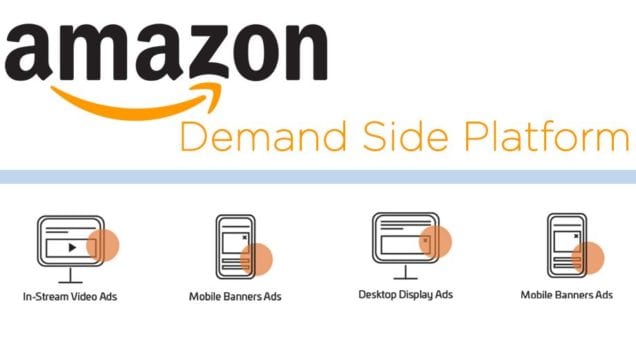In short, it connects the buyers most likely to make a purchase using display advertising both on the Amazon platform and off of it. Amazon has millions of shoppers each day browsing products. Yet, it’s difficult for product advertisers to capture the attention of those shoppers because of the steep competition.
Paid search ads are a common route, but it’s hard to keep costs in line with goals with so much competition. With DSP, it is possible to capture a larger stake in that audience by driving awareness and reaching out directly to those qualified customers. You can do this at all stages of their eCommerce customer journey. In short, it’s critical.
How Does DSP Work?
DSP is a demand-side platform. It lets advertisers buy digital advertising inventory and enables the management of various ad and data exchange accounts into a single interface. In addition, it offers flexibility to companies because it allows for self-management of programmatic digital media campaigns. That means that those doing the advertising have more opportunities to build the brand’s awareness and, ultimately, to build sales both on Amazon and on other platforms.
One of the key benefits is that DSP can be scaled to meet existing needs. It can be used to target highly qualified in-market shoppers. It does this across all of Amazon’s apps and sites, as well as most leading publisher sites and mobile apps. That’s done using third-party exchanges.
At the Heart-Targeting
One of the most important parts of the demand side platform is that it provides an opportunity to create highly targeted ads for people who are most likely to be the company’s customers. That means less money is spent on ads that do not produce the desired results.
During the creation of a campaign, companies can create customized audience segments. This can be done for specific products or categories. It works to ensure the very user experience. Why is this so beneficial on Amazon? When you consider the overall size of Amazon and the incredible amounts of valuable, real, and up-to-date data that the company has about shoppers, it is clear that this is one of the best opportunities for targeting customers. That data becomes valuable in creating campaigns.
What’s more, with Amazon DSP, it’s possible to create a number of campaigns using the wide range of targeting options provided. This clearly creates an advantage over just about any other platform offering demand side advertising.
There are various targeting options vital to advertising here, including:
- Contextual: This targets shoppers who are currently looking at products that are related to the products or services or the brand in general
- In-market: This opportunity focuses on shoppers who have had some interest in the last 30 days to purchase a product, not just a specific item, but in any of Amazon’s related subcategories
- Lifestyle: This option allows for choosing specific targets based on their lifestyle choices, such as vegan, pets, or fitness
- Remarketing: This allows for coming back to a customer who has already engaged with a product by searching for it on the platform, viewing the details page, or even purchasing it before
- Audience lookalike: This is a targeting option focused on presenting ads to people of similar demographics or shopping behaviors to the brand’s current customer base
- Advertiser audiences: This option allows for advertising using a list of customers provided by the company
There are more options as well. This shows the breadth and expansiveness of the data available to advertisers using this platform.
DSP Ad Types: How to Get a Message to Customers
Recognizing how effective targeting on Amazon can be, the next step is to determine the best ad type to use to reach those customers. The Amazon DSP advertising options include display ads and video ads. Many campaigns include both options.
These ads appear on numerous platforms. That includes Amazon.com, but also on the sites owned by the company, such as Goodreads and IMDB. They are also found on third-party mobile apps and on various other websites. In short, there is an extensive range of locations these ads can be placed.

There is a lot of control for the advertiser. That means they can choose what works for their campaign and, in many cases, achieve the goal they have to reach the highest number of customers without overspending to do so.
Monitoring Campaign Success
Amazon DSP provides a number of resources to help advertisers monitor how their campaigns are succeeding and when and how to make tweaks to it to achieve the best outcome. This is done through metrics.
Amazon provides a large range of metrics, including audience insights. The benefit of having multiple data points like this is that it allows for advertisers to create a better understanding of their audience which, then allows them to create ads that work for that group. Not only is it possible to improve the targeting range, but it also helps to control ad spend, which is critical to many businesses today.
One area of this is deals metrics. Amazon DSP provides a deals page. This page shows all of the company’s private marketplace deals as well as the bid metrics. That includes things like the response counts and bid rate. This can help advertisers to see just how healthy and effective their deals are and whether or not they are working properly.
What Are the Benefits of Using Amazon DSP?
Take a closer look at some of the ways Amazon DSP works to support brands and products.
- Increase customer reach: The service works to allow advertisers to programmatically buy ads so that they can connect with prospective customers anywhere. Remember, this is not just about product listings on Amazon but on various platforms outside of the site.
- Use metrics for decision making: Another core benefit of DSP is that it provides in-depth, high-quality data. That data can help companies to make far better decisions about their products. The metrics themselves allow for performance reporting as much as needed. There is no additional cost for using this either.
- Relevant placement: With the use of Amazon DSP, it is possible to meet the customer where they are. More specifically, the insights provided, including shopping signals, allow advertisers to connect with the most likely shoppers and audience. That helps to extend ROI for many organizations.
- Brand standards are maintained: Amazon does an excellent job of ensuring brands are protected. This is done through manual site reviews and even real-time bid evaluations. That helps to ensure the quality standards on the site and helps to provide brand safety to companies.
Commonly Asked Questions About DSP
Amazon DSP can be a bit confusing, which is why there are some outstanding tools available to help advertisers learn to use and get the most out of it. There are some key questions that may help.
Who is able to use Amazon DSP?
While it requires an account to be set up on the site, Amazon DSP is available to those who sell products on the site and those who do not. It can be accessible and beneficial to many advertisers.
Can you use DSP without selling products directly on Amazon?
Yes, this is one of the core benefits of the program. It enables people to use Amazon DSP who are selling on Amazon as well as those that do not sell products on Amazon. The rich data and insights available for competitor products can most certainly help with advertising anywhere. However, these ads are not just placed on the site but on numerous websites.
Is DSP self-served or managed services?
There are both managed services and self-services available. Self-service means that the advertiser is able to control their campaign fully on their own. Managed services are available and may be ideal for those that want access to key features, such as Amazon DSP inventory and a consultant service. It can also be beneficial for those who do not have a lot of experience with programmatic advertising itself. Keep in mind that to use the managed service option, there is generally a required $35,000 USD spend necessary.
What is programmatic advertising?
As one of the most important tools for advertising today, programmatic advertising is a type of automated buying and selling of digital advertising inventory. That term refers to the space available for ads on a website. Programmatic ads are used heavily in digital marketing today because of how effective and efficient they can be.
Who creates the ads?
It is possible for advertisers to create their own custom ads. Amazon also offers other options, including eCommerce creative templates and a video creative builder to help. These services can help with automatically generating ads that the company says are most likely to create the desired results. Advertisers have complete freedom when it comes to the type of ads they want to use.
